Difference between revisions of "Amahi in Proxmox without Greyhole"
| (3 intermediate revisions by the same user not shown) | |||
| Line 4: | Line 4: | ||
heading =WARNING| | heading =WARNING| | ||
message = This is recommended only for advanced users, proceed with caution.}} | message = This is recommended only for advanced users, proceed with caution.}} | ||
| − | + | [https://wiki.amahi.org/index.php/Amahi_Virtualized Back to 'Amahi Virtualized'] | |
<h2>Amahi in a Proxmox VM (without Greyhole) - a 15-step Run-through</h2> | <h2>Amahi in a Proxmox VM (without Greyhole) - a 15-step Run-through</h2> | ||
| Line 53: | Line 53: | ||
- the model option yields tiny differences in results.<br /> | - the model option yields tiny differences in results.<br /> | ||
'Intel E1000' tends to be the most compatible for a server.<br /> | 'Intel E1000' tends to be the most compatible for a server.<br /> | ||
| − | You may of course try with any of these, keeping in mind that the Fedora or Ubuntu OS may rename the interface after | + | You may of course try with any of these, keeping in mind that the Fedora or Ubuntu OS may rename the interface after such a change (Amahi depends on seeing 'eth0' as of Amahi6/ Fedora14)<br /> |
- setting a MAC address is auto by default and rate limit is also unlimited by default. You may change these as you see fit.<br /> | - setting a MAC address is auto by default and rate limit is also unlimited by default. You may change these as you see fit.<br /> | ||
- .. then click "Next"</li> | - .. then click "Next"</li> | ||
| Line 59: | Line 59: | ||
The final tab will show you a confirmation of the settings you made. Go back and make changes if need be.<br /> | The final tab will show you a confirmation of the settings you made. Go back and make changes if need be.<br /> | ||
Once ready and happy, click "Finish" and the VM will be created. <br /> | Once ready and happy, click "Finish" and the VM will be created. <br /> | ||
| − | The | + | The VM is ready when you see it in the left side column of the main GUI, under the 'Server' view, with your Proxmox node expanded.</li> |
<li> | <li> | ||
In its current state, your new VM is off, and also NOT set to start automatically when the Proxmox node boots up. This setting can be changed later, as you see fit.<br /> | In its current state, your new VM is off, and also NOT set to start automatically when the Proxmox node boots up. This setting can be changed later, as you see fit.<br /> | ||
| Line 66: | Line 66: | ||
To simplify storage on this VM, you can setup any drive config you please. To start, we shall add a single drive image to the VM to act as the storage mount, typically known to Amahi users as '/var/hda/files'.<br /> | To simplify storage on this VM, you can setup any drive config you please. To start, we shall add a single drive image to the VM to act as the storage mount, typically known to Amahi users as '/var/hda/files'.<br /> | ||
- Under the 'hardware' tab, click "add" > "hard disk" > 'VIRTIO' > device '1' > storage 'local'<br /> | - Under the 'hardware' tab, click "add" > "hard disk" > 'VIRTIO' > device '1' > storage 'local'<br /> | ||
| − | - Decide how big this drive is to be. It is limited only by how much 'local' storage is available in that Proxmox partition. Once again the remaining options are up to you, but leave cache at 'default'. If you wish you include thise drive in backups and snapshots when Proxmox is instructed to do those, this drive will be included. Finally, click "Add" and this drive is added to the VM</li> | + | - Decide how big this drive is to be. It is limited only by how much 'local' storage is available in that Proxmox partition. Once again the remaining options are up to you, but leave cache at 'default'. If you wish you include thise drive in backups and snapshots when Proxmox is instructed to do those, this drive will be included (Keep in mind backups effectively consume duplicates of what they are backing up!). Finally, click "Add" and this drive is added to the VM</li> |
<li> | <li> | ||
At this point, with the HDA VM highlighted, click the "Start" button at the top right of the window and it will boot up. Right away, click the "console" button just to the right of the migrate button. <br /> | At this point, with the HDA VM highlighted, click the "Start" button at the top right of the window and it will boot up. Right away, click the "console" button just to the right of the migrate button. <br /> | ||
| Line 78: | Line 78: | ||
After OS installation is complete. You may turn on the auto-boot and even select the order in which this VM boots around other VMs in Proxmox.<br /> | After OS installation is complete. You may turn on the auto-boot and even select the order in which this VM boots around other VMs in Proxmox.<br /> | ||
[[File:Prox-nogrey-05.png]]<br /> | [[File:Prox-nogrey-05.png]]<br /> | ||
| − | *It is suggested that if | + | *It is suggested that if your HDA is definitely going to be your DNS and DHCP server, that it boots as '0' (first).<br /> |
</li> | </li> | ||
</ol> | </ol> | ||
<br /> | <br /> | ||
| − | .... | + | * [http://forum.proxmox.com/threads/2537-quot-qcow2-quot-vs-quot-raw-quot-KVM-Disk-Format forum reading for qcow2 vs raw] |
| + | * [http://www.linux-kvm.org/page/Qcow2 KVM reference from Red Hat] | ||
[[Category:Virtualization]] | [[Category:Virtualization]] | ||
Latest revision as of 12:34, 23 May 2013
| WARNING | |
|---|---|
| This is recommended only for advanced users, proceed with caution. |
Amahi in a Proxmox VM (without Greyhole) - a 15-step Run-through
This tutorial will skip installation of Proxmox, as that is covered by Proxmox documentation.
The only particular to understand during Proxmox installation is that all drives in the machine at time of install will become part of a LVM group that Proxmox will call "local storage" for images, containers, folders, etc as well as a partition in the LVM for the Proxmox OS itself. Any drives you wish to exclusively use for Greyhole storage pooling would need to be powered-on/ connected after installation of Proxmox. This turorial is for a setup without Greyhole. This being the case, take not that you will need sufficient storage available in your "local storage" in the Proxmox node (each node is a single hardware server), or have a NFS share or iSCSI share or other LVM group storage for disk images.
Before we begin, make sure you can run the web GUI in your browser, and you have the latest version of JAVA installed in your browser, as the console views rely on it.
We will begin with setting up the Amahi VM inside the web GUI, which is accessible via the default IP
x.x.x.4:8006 (where x is the first 3 octets of your network)
- Click on "Create VM" at the top right corner
-
Choose the node, VM number (defaults to the next available), name (anything you like such as 'HDA', or 'Amahi'), and the resource pool to fall under (will need to be defined beforehand) (resource pool is just a pseudo-logical way of looking at stats for several VMs) .. then click "Next"
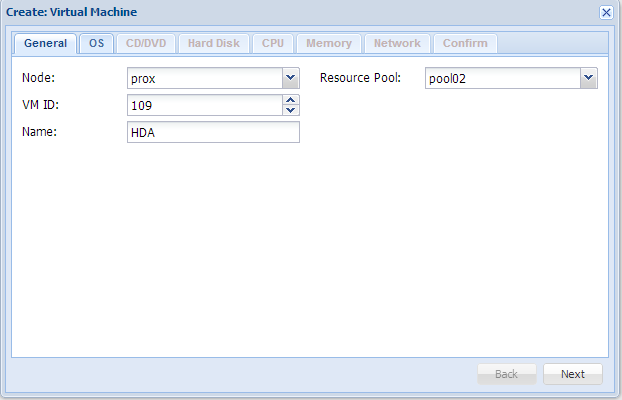
- Choose the Linux 2.6/3.x kernel type .. then click "Next"
-
Choose the "Use CD/DVD disc image file (iso)" option. Then find the storage area (usually 'local') where your Fedora or Ubuntu ISO resides .. then click "Next"
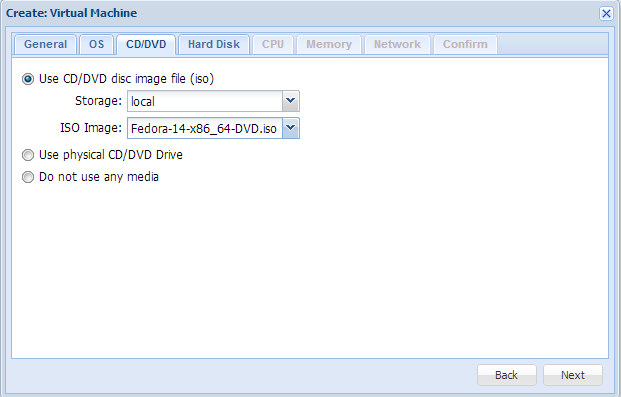
-
In the Hard disk tab, you have several options.
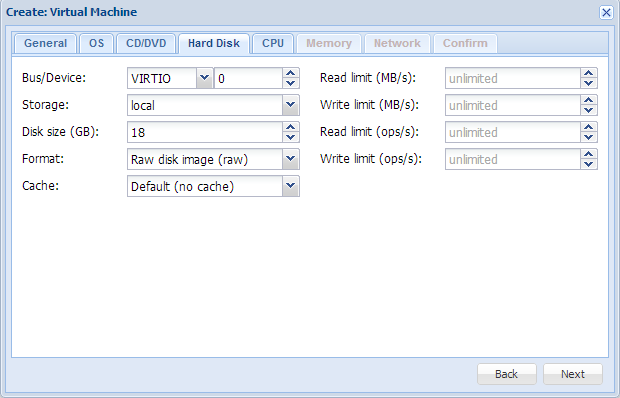
- Start with VIRTIO. This is a abstracted, optimized interface for drive images. As this is the first disk, it will be device '0'.
- Choose the storage volume that will contain this image; typically the "local" unless you have setup something else.
- Choose the disk size in gigabytes. As this is the first disc, unless you have particular needs, 16-20GB is sufficient as this will only be holding your Fedora/Ubuntu OS drive contents (/, /home, swap).
- Choose the format of the image. This is up to you as there are pros/cons for the options. Suggest to google the types to see what works best for you. "Raw" amd "qcow2' both have similar compatibilities.
- leave the cache option at "Default (no cache)"
- read and write limits are up to you, but are best left at unlimited unless you've previous experience with such limitations
- .. then click "Next" -
The following tab is for CPU options
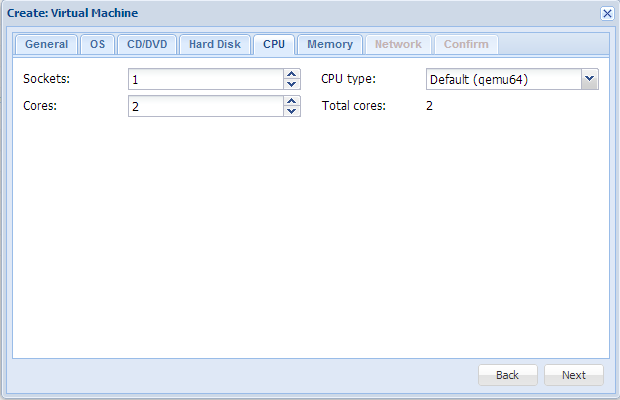
This tab decides how much CPU to give to your Amahi VM. Choose options that meet or exceed the minimum system requirements for your chosen OS (Fedora/ Ubuntu).
- start with 2 core and 1 socket and a 'qemu64' CPU type. You can always go back and change it.
- .. then click "Next" -
The memory tab decides the amount of system RAM you give the VM. This is also your own choice, depending on what you want to be able to do with your Amahi VM. Settomg 1GB (1024MB) is sufficient. You can always go back and change it.
- .. then click "Next" -
This next network tab decides what kind of networking to give the VM.
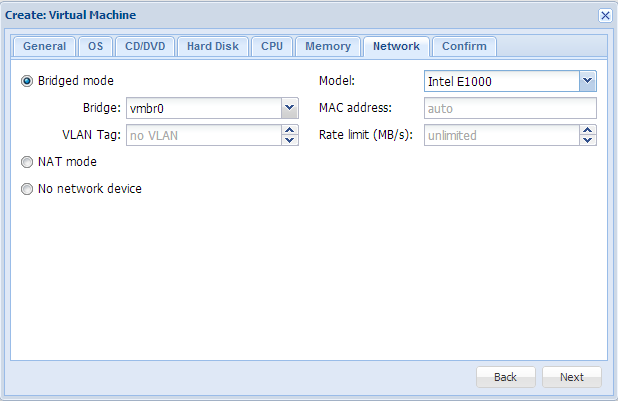
- go for "bridged mode" as we want the VM to look like a real device on the LAN
- the default bridge is always vmbr0 and it also shares traffic with the web GUI console. If you have no additional NICs in the physical machine, this will be the only bridge to use.
- the model option yields tiny differences in results.
'Intel E1000' tends to be the most compatible for a server.
You may of course try with any of these, keeping in mind that the Fedora or Ubuntu OS may rename the interface after such a change (Amahi depends on seeing 'eth0' as of Amahi6/ Fedora14)
- setting a MAC address is auto by default and rate limit is also unlimited by default. You may change these as you see fit.
- .. then click "Next" -
The final tab will show you a confirmation of the settings you made. Go back and make changes if need be.
Once ready and happy, click "Finish" and the VM will be created.
The VM is ready when you see it in the left side column of the main GUI, under the 'Server' view, with your Proxmox node expanded. -
In its current state, your new VM is off, and also NOT set to start automatically when the Proxmox node boots up. This setting can be changed later, as you see fit.
Congrats! you've created the virtual machine that your HDA will use. -
To simplify storage on this VM, you can setup any drive config you please. To start, we shall add a single drive image to the VM to act as the storage mount, typically known to Amahi users as '/var/hda/files'.
- Under the 'hardware' tab, click "add" > "hard disk" > 'VIRTIO' > device '1' > storage 'local'
- Decide how big this drive is to be. It is limited only by how much 'local' storage is available in that Proxmox partition. Once again the remaining options are up to you, but leave cache at 'default'. If you wish you include thise drive in backups and snapshots when Proxmox is instructed to do those, this drive will be included (Keep in mind backups effectively consume duplicates of what they are backing up!). Finally, click "Add" and this drive is added to the VM -
At this point, with the HDA VM highlighted, click the "Start" button at the top right of the window and it will boot up. Right away, click the "console" button just to the right of the migrate button.
This will launch a window which will be the display for the VM. You will see a normal boot that will boot from the ISO you selected earlier. - During installation, you can setup the second drive you added to mount '/var/hda/files', thus creating your shares partition right away at install of Fedora/Ubuntu.
-
Installation at this time is just the same as documented by the OS and in the Amahi installation procedures. Please refer to those until your next boot.
** Remeber to remove the ISO from the virtual CDROM drive when required, by selecting the VM in the list and going to: "hardware" tab > select "CD/DVDROM drive" > click "Edit" > select "Do Not Use Any Media" -
After OS installation is complete. You may turn on the auto-boot and even select the order in which this VM boots around other VMs in Proxmox.
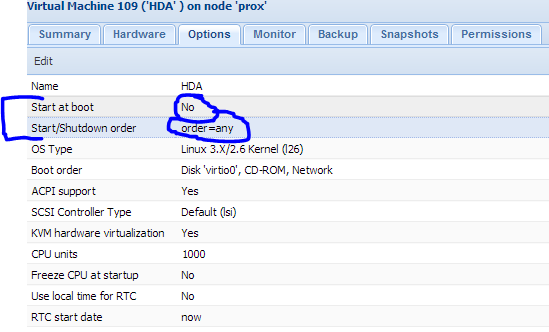
*It is suggested that if your HDA is definitely going to be your DNS and DHCP server, that it boots as '0' (first).
